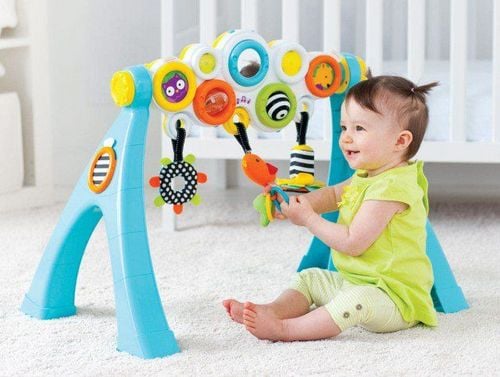This is an automatically translated article.
In addition to night sleep, daytime naps such as napping are equally important. They're key to making sure kids get the rest they need each day. Plus, naps have amazing effects on children's physical health and mood. However, not all parents know how to put their baby to nap.
1. Why is napping important to children?
As children grow and develop, naps give their bodies and minds enough time to rest and recharge after hours of constant exercise. Plus, if your child is too tired, he or she will have a harder time sleeping at night. In addition, naps have other benefits for children, such as:Naps help children learn better: A study of preschool children found that naps help children play good memory games. than. The people who get the biggest benefit from napping are those who get into the habit of napping every day. Naps help children stay healthy: Research shows that children who don't get enough sleep or sleep irregularly are more likely to be obese. Part of the reason may have to do with the way children eat when they're tired. Some studies have found that children tend to eat more when they don't get enough sleep. Children also tend to choose unhealthy foods. Plus, when kids are tired, they won't have as much energy to function and get enough exercise, another important part of a healthy body.
More sleep, good mood : Days without naps can cause kids to have tantrums and tears and science proves it, a study found 2-year-olds skip naps will be less happy, more anxious, and have worse reactions to unpleasant events.

Giấc ngủ trưa giúp trẻ có một cơ thể khỏe mạnh và tâm trạng tốt.
2. How long does a child need a nap?
Newborns until about 3 months old, they will sleep a lot. Babies can sleep up to 18 hours a day and usually wake up only an hour or two at a time to eat and go to the bathroom. From infancy until before a baby is 1 year old, babies need two to four naps a day. Children can rest anytime from 30 minutes to 2 hours.
Toddlers: Children this age should sleep between 12 and 14 hours a day, including naps during the day. Between the ages of 1-2, most toddlers go from two naps a day to one nap, which usually takes place in the early afternoon. When that happens, the remaining nap can last up to 3 hours. Preschoolers: After age 2, not all children need a nap, although some 3 or 4 year olds will still benefit from this nap. Preschoolers need 11 to 13 hours of sleep a day, but it's more important for them to rest at night than nap. Therefore, if the child cannot sleep at night, parents should shorten the nap time of the child. Children after 5 years old: At this age children do not need naps anymore. But taking a mid-day break can work wonders for kids and teens. Try to keep the nap short to around 30 minutes and make sure to wake up early in the afternoon. That way, the nap won't disturb your baby's bedtime.
3. The secret to a better afternoon nap
Even if you know how effective a nap can be, it's hard to get kids to nap. To make naptime easier, you should pay attention to a few points:
Keep your child in a good mood: Comfort should be created and should not be forced to sleep immediately. Also, let your child nap at the same time and in the same spot every day, if possible. Need to sleep at the right time: When you see that your baby is sleepy with signs like he is yawning or rubbing his eyes, put him down in a cool, dark and undisturbed room to make it easier for him to fall asleep. Keeping naps short: Researchers studied how naps affect toddlers' nighttime sleep and found that the longer and later a child naps, the harder it is to fall asleep at night. night. If your child isn't ready to give up naps yet, try shortening the rest period and putting him to bed earlier at night.
4. How to give your baby an effective nap
Yawning is the most basic sign that a baby is starting to fall asleep. In addition, the baby may also have a few other signs such as rubbing eyes, fussiness. Overly tired babies often have a harder time settling down to sleep, so watch out for these signs. Older babies may also act clumsy, clingy and hyperactive when they are sleepy.
4.1. What to do when napping Know that babies sleep a lot: babies can sleep for about 16 hours a day, waking up to feed and change. As children get older, they need less sleep during the day and more at night. At 6 months, some babies can sleep through the night plus two to three daytime naps. However, you should not be too worried if they do not nap, because each baby will sleep differently. Feed, break, then nap: It's natural for babies to fall asleep after a feed. And breastfeeding or bottle-feeding your newborn is a great way to feel close to your baby. However, over time this may become the only way a child can fall asleep. So babies should learn to fall asleep on their own. Try to separate breastfeeding from napping even for a few minutes. You can replace breastfeeding by reading stories or changing diapers. Make napping a habit: Establish a good nap routine and do it when possible. You can help your child sleep better by: Avoiding late naps if your child has trouble falling asleep at night, schedule nap times earlier, or wake them up early before napping. Using a crib at night is also a way to help babies sleep better. Let your baby fall asleep on his own: You need to teach your baby to fall asleep on his own without being held, rocked, or fed. This can also help children learn to fall back to sleep on their own if they wake up at night. Think baby's safety in sleep: If your baby falls asleep in a chair, bed, or floor, move him or her into the crib. Those places are not safe for children to sleep. Always place babies on their backs to sleep to help prevent sudden infant death syndrome (SIDS). Remove blankets, pillows, stuffed animals, cushions, and other soft items from your baby's crib or crib. Do not put children to sleep with children or other pets.

Luôn đặt trẻ nằm ngửa khi ngủ để giúp ngăn ngừa hội chứng đột tử ở trẻ sơ sinh (SIDS).
Besides sleep, nutrition is also important for a child's development. For children to be healthy and develop well, it is necessary to have a nutritious diet in terms of quantity and quality balance. If children are not provided with adequate and balanced nutrients, it will lead to diseases of excess or lack of nutrients, which adversely affect the comprehensive development of children in terms of physical, mental and motor skills.
Parents should supplement their children with supportive products containing lysine, essential micro-minerals and vitamins such as zinc, chromium, selenium, and B vitamins to help fully meet their child's nutritional needs. At the same time, these essential vitamins also support digestion, enhance nutrient absorption, help improve anorexia, and help children eat well.
Parents can learn more:
Signs of zinc deficiency in children
Micronutrient deficiency and failure to gain weight in children
Please regularly visit Vinmec.com website and update useful information to take care of your child. Take care of the baby and the whole family.
Reference source: webmd.com













